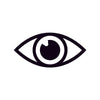Comfort and wearability matter when choosing the right glasses. That’s why selecting a lens thickness you can wear all day is essential. Thanks to advancements in eyewear technology, thick, heavy lenses are no longer a concern. At 1001 Optometry, we offer a range of options, so you’ll find the perfect fit. Explore our prescription lenses today.
Lens refractive index explained
The refractive index of a lens measures how efficiently it bends (refracts) light. It determines how much the lens material can slow down and redirect light rays to correct vision.
Higher Refractive Index = Thinner Lenses
Lenses with a higher refractive index bend light more effectively, meaning they require less material to achieve the same prescription strength. As a result, high-index lenses are thinner and lighter than standard lenses with the same prescription.
factors affecting lens thickness
Lens thickness impacts both aesthetics and comfort in prescription eyeglasses. Several factors influence lens thickness, including prescription strength, lens material, frame shape, and lens design.
prescription strength
-
Myopia (Nearsightedness): Higher negative (-) prescriptions have thinner centers and thicker edges.
-
Hyperopia (Farsightedness): Higher positive (+) prescriptions have thicker centers and thinner edges.
-
Astigmatism & Other Corrections: May affect lens thickness in specific areas.
-
Solution: High-index lenses reduce thickness for stronger prescriptions.
lens material
-
Standard Plastic (CR-39): Affordable but thicker.
-
Polycarbonate: Thinner and impact-resistant.
-
High-Index Lenses: Ideal for strong prescriptions, offering a thinner, lighter option.
-
Trivex: Lightweight with excellent clarity.
frame shape
-
Smaller Frames: Reduce lens thickness, especially for high prescriptions.
-
Round/Oval Frames: Minimize edge thickness for myopic prescriptions.
-
Rimless/Semi-Rimless Frames: Require durable materials but can highlight thickness.
lens design and material
-
Aspheric Lenses: Thinner and flatter, reducing distortions.
-
Bifocal & Progressive Lenses: May vary in thickness, with progressives offering seamless transitions.
aesthetics
Thinner lenses enhance eyewear appearance, preventing the "coke bottle" effect. To improve aesthetics:
-
Choose high-index lenses for minimal bulk.
-
Pick frames that complement lens thickness.
-
Use anti-reflective coatings to reduce glare.
By understanding these factors, you can achieve the best balance of vision correction, comfort, and style.
our lens thickness options
1001 Optometry offers a range of lens thickness options to suit every individual’s needs, whether you’re looking for a lightweight, ultra-thin lens or a more cost-effective standard option. Our expert team will help you find the perfect balance of comfort, durability, and aesthetics.
Here’s the filled-in table based on the lens thickness options:
| Lens Classification | Lens Index | Features | Best For | SPH Range | CYL Range |
|---|---|---|---|---|---|
| Standard Lens | 1.5 | Affordable, default choice, thicker for high prescriptions | Low prescriptions | 0.00 to ±2.00 | 0.00 to ±1.50 |
| Mid Index Lens | Between 1.5 & 1.6 | Balance between performance and affordability, thinner than standard but not as thin as high index | Medium prescriptions | ±2.00 to ±4.00 | ±1.50 to ±2.50 |
| High Index Lens | 1.6+ | Extremely thin and lightweight, superior optical quality, more expensive | High prescriptions | Above ±4.00 | Above ±2.50 |
STANDARD LENS (1.5 INDEX)
These lenses are the default choice, offering a basic and affordable option for everyday use. They are best suited for lower prescriptions but can become noticeably thicker for higher prescriptions.
Pros:
✔ Affordable and included with most frames
✔ Provides good optical clarity for low prescriptions
Cons:
✖ Thicker than other lens options, especially for higher prescriptions
✖ Can be heavier, making them less comfortable for prolonged wear
✖ May cause more distortion around the edges for stronger prescriptions
Best for:
🔹 Low prescriptions (generally up to +/-2.00)
🔹 Budget-conscious buyers who don’t mind slightly thicker lenses
MID INDEX LENS (BETWEEN 1.5 & 1.6)
These lenses provide a balance between affordability and performance, offering a thinner and slightly lighter alternative to standard lenses.
Pros:
✔ Thinner than standard lenses, offering a more stylish look
✔ Lighter than standard lenses, improving comfort
✔ Reduces some edge distortion for moderate prescriptions
Cons:
✖ Still not as thin or lightweight as high-index lenses
✖ May not be suitable for very strong prescriptions
Best for:
🔹 Medium prescriptions (around +/-2.00 to +/-4.00)
🔹 Those who want a balance of affordability and aesthetics
HIGH INDEX LENS (1.6 +)
These lenses are designed for high prescriptions, significantly reducing thickness and weight while maintaining excellent optical quality. The higher the index, the thinner and more lightweight the lens.
Pros:
✔ Ultra-thin and stylish, great for strong prescriptions
✔ Lightweight for enhanced comfort
✔ Reduces edge distortion and the "coke bottle" effect seen in thick lenses
✔ Ideal for larger frames without excessive lens thickness
Cons:
✖ More expensive than standard and mid-index lenses
✖ May be more prone to reflections (anti-reflective coating recommended)
Best for:
🔹 High prescriptions (above +/-4.00)
🔹 People who want a sleek, lightweight, and stylish look
🔹 Those who wear glasses daily and prioritize comfort
how to choose the right lens thickness for your eyes
Selecting the appropriate lens thickness is essential for both comfort and aesthetics. Lens thickness in eyeglasses is influenced by three main factors: prescription strength, lens material (index), and frame shape. High-index lenses provide thinner, lighter options for stronger prescriptions, improving both wearability and appearance.
consider your prescription strength
The strength of your prescription directly impacts the thickness of your lenses:
-
Mild Prescriptions: Standard index lenses (1.5) are typically sufficient.
-
Moderate to Strong Prescriptions: High-index lenses (1.6, 1.67, 1.74) are recommended as they bend light more efficiently, allowing for thinner and lighter lenses.
-
Very Strong Prescriptions: The highest index available (1.74) can reduce lens thickness by up to 45% compared to standard lenses.
consider your frame shape
The frame you choose plays a crucial role in how thick your lenses appear:
-
Narrower Frames: These help reduce the noticeable edge thickness for strong prescriptions.
-
Full-Rim Frames: These can help conceal thicker lens edges better than rimless or semi-rimless frames.
-
Rimless or Semi-Rimless Frames: Work best with thinner lenses (such as high-index lenses) to maintain durability and aesthetics.
consult with an eyecare professional
An optometrist or optician can assess your prescription and lifestyle needs to recommend the best lens material and thickness for you. They can also suggest coatings and other features to enhance lens performance and comfort.
comfort and wearability
Beyond thickness, consider factors that impact daily comfort:
-
Weight: Lighter lenses provide a more comfortable fit, especially for extended wear.
-
Durability: High-index lenses are more fragile, so choosing impact-resistant materials might be necessary.
-
Aesthetic Appeal: Thinner lenses can enhance the overall look, especially for those with strong prescriptions.
By considering these factors, you can choose the right lens thickness for both visual clarity and everyday comfort.
additional lens add-ons to consider
There are additional elements to consider when choosing your lenses, allowing you to customize them to suit your needs. Explore our options for progressive lenses or single vision lenses.
Additional lens add-ons to consider:
-
Progressive or single lenses: Choose between multifocal progressive lenses for seamless vision correction or single vision lenses for specific distances.
-
Lens coatings (anti-scratch / anti-glare): Enhance durability and clarity with coatings that reduce glare and protect against scratches.
-
Optional transition lenses: Experience adaptive lenses that darken in sunlight and remain clear indoors for added convenience.
lens thickness cost breakdown
-
1.5 Standard: Free scratch resistance and UV protection. Suitable for Sphere Power up to +/- 1.50. $0.00
-
1.56 Thin: Free scratch resistance, UV protection, and anti-reflection. Suitable for Sphere Power up to +/- 2.00. $60.00
-
1.6 Thinner + Lighter: Free scratch resistance, UV protection, and anti-reflection. Suitable for Sphere Power up to +/- 3.00. $120.00
-
1.67 Super Thin + Light: Free scratch resistance, UV protection, and anti-reflection. Suitable for Sphere Power up to +/- 4.00. $180.00
-
1.71 Ultra Thin + Light: Free scratch resistance, UV protection, and anti-reflection. Suitable for Sphere Power up to +/- 4.00 and above. $280.00
getyour desired lens thickness with 1001 Optometry
Whether you’re shopping online or visiting one of our NSW or VIC locations, 1001 Optometry’s expert team is here to help you select the ideal lens thickness for your needs. We offer personalized advice to ensure you get the perfect fit, combining style, comfort, and clarity. Visit us today or explore our options online to get started!


